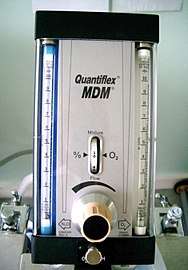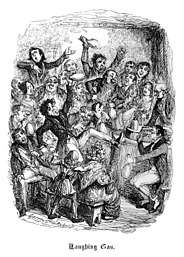Inhalation sedation

Inhalation sedation is a form of conscious sedation where an inhaled drug should:
- Depress the central nervous system (CNS) to an extent that allows operative treatment to be carried out with minimal physiological and psychological stress
- Modify the patient's state of mind such that communication is maintained and the patient can respond to verbal command
- Carry a margin of safety wide enough to render the unintended loss of consciousness and loss of protective reflexes unlikely.[1]
Medical uses
The following are possible uses for conscious sedation "dental anxiety and phobia, a need for prolonged or traumatic dental procedures, medical conditions potentially aggravated by stress (such as ischaemic heard disease, hypertension, asthma and epilepsy), medical or behavioural conditions affecting a patient's ability to cooperate, special care requirements".[2]
Side effects
Complications arising in inhalation sedation are rare and are termed as are those which require intervention in order to correct adverse physiological consequences that can inadvertently accompany the sedation technique.[3] They include "over-sedation, respiratory depression/apnoea, unconscious patient, airway obstruction, vomiting, idiosyncratic responses, delayed recovery and failure of conscious sedation".[3]
Few absolute contraindications exist, however, "relative contraindications are important and can only be considered following a full assessment."[4] They include:
- Medical conditions which would compromise the inhalation of the sedation medication, such as the common cold, tonsillitis, severe COPD or nasal blockage;
- Neuromuscular diseases affecting the respiratory system, such as multiple sclerosis and myasthenia gravis;
- Women in the first trimester of pregnancy;
- Medical or behavioural conditions which would limit a patient's ability to understand the procedure;
- Claustrophobia or "fear of the mask".
Patient assessment and selection

On a visit prior to the treatment session, a full assessment is carried out in order to deduce the need for sedation and the technique most suited to the individual patient.[2] This consists of a detailed record of the patient's history and a thorough examination:
A medical, dental and social history taken takes into account the patient’s age, state of health, social circumstances, drug history and any special needs, in order to determine that the conscious sedation technique chosen is the most appropriate to enable successful treatment outcomes for each individual.[4]
An examination takes into account the patient's general appearance, skin colour, pulse, blood pressure and respiration rates.[4]
It is recommended that "only patients in ASA classes I and II should normally be considered suitable for sedation in the primary care dental setting" and that "patients in ASA class III or IV should be referred to an appropriate secondary care (i.e. hospital) establishment which has critical care facilities."[4]
Equipment & safety features

In the UK, machines used for the administration of inhalation sedation should follow the British Standards[5] and be well-maintained according to the manufacturer's guidance.
Equipment
Equipment used for inhalation sedation for dentistry include:[6]
- Gas cylinders
- Flowmeter
- Reservoir bag
- Conduction Tubing
- Breathing apparatus (Nasal hood or face mask)
Safety features
Oxygen fail safe mechanism is the most important safety feature of the equipment used in inhalation sedation.[6] Nitrous oxide flow is only allowed via an opened valve when there is flow of oxygen to the system.[6] In any circumstances when oxygen flow is less than 30%, nitrous oxide stops flowing.[6] This prevents the potential delivery of 100% nitrous oxide and it becomes a standard on every sedation unit made today.[6]

All nasal hoods should have scavenging ability— provide fresh gas to the patient through one or two hoses while the extra hoses eliminate exhaled gas by the patient via a vacuum system.[6]
A pin index safety system is in place in order to prevent incorrect fitting of the two cylinders in the wrong position.[6] In addition, the cylinders are colour coded which further reduces the risk of incorrect cylinder placement.[7]
A diameter index system is also in place in order to prevent incorrect linking of hoses and stems as the attachment couplings as well as hoses and stems are different in diameter.[6]
Pressure relief devices which dissipate contents of the cylinder to the atmosphere prevent explosion of cylinder due to over-filling.[7] In an emergency, an oxygen flush or emergency oxygen system passes a high flow of high pressure oxygen direct from the source bypassing intermediate meters.[7]
Several alarm systems are used to indicate a depleting oxygen supply. Audible alarms are required in Europe and are recommended in the United States.[6]
History

Nitrous oxide was first discovered by Joseph Priestley in 1772.[8] In 1795, Sir Humphrey Davy and surgeon J. B. Borlase experimented with nitrous oxide and the effects of its inhalation.[8] Davy then published a book in 1799 hinting the possible role of nitrous oxide in achieving mild anaesthesia during surgical procedures.[8] In 1824, Henry Hill Hickman used carbon dioxide to achieve a state of "suspended animation" in animals; successfully diminishing pain during the surgical procedure.[8] In 1831, chloroform was discovered by Justus von Liebig in Germany, Samuel Guthrie in New York and Eugène Soubeiran in France, all of whom worked independently.[8] In 1842, a chemist in Rochester, William Edward Clarke provided Dr. Elijah Pope with ether prior to a tooth extraction of his patient.[9] In the same year, a doctor in Georgia, Dr. Crawford W. Long administered ether to John Venable for the removable of a neck tumour.[8] In 1844, Dr. Horace Wells carried out an experiment on himself where he had Professor Gardner Quincy Colton administer nitrous oxide to himself prior to a wisdom tooth extraction by Dr. John Riggs.[8] Wells discovered that he was unaware of the procedure and experienced absolutely no pain during the procedure.[8]
References
- ↑ M., Girdler, N. (2009). Clinical sedation in dentistry. Hill, C. M., Wilson, K. E. (Katherine Elizabeth), 1963-. Chichester, U.K.: Wiley-Blackwell. ISBN 9781444312201. OCLC 437132993.
- 1 2 "Conscious Sedation in Dentistry" (PDF). Scottish Dental Clinical Effectiveness Programme. June 2017.
- 1 2 "Standards for Conscious Sedation in the Provision of Dental Care: Report of the Intercollegiate Advisory Committee for Sedation in Dentistry (IACSD)". 22 April 2015. Retrieved 30 Dec 2017.
- 1 2 3 4 "BDA Advice - Conscious Sedation" (PDF). baos.co.uk. November 2011. Retrieved 30 December 2017.
- ↑ "Anaesthetic and analgesic machines". British Standard Institution. BS4273. 1997.
- 1 2 3 4 5 6 7 8 9 S.Clark, L.Brunick, Morris, Ann (2015). Handbook of Nitrous Oxide and Oxygen sedation. St Louis, Missouri: Elsevier Mosby. ISBN 978-1-4557-4547-0.
- 1 2 3 Subrahmanyam, M; Mohan, S (2013). "Safety Features in Anaesthesia Machine". Indian Journal of Anaesthesia. 57 (5): 472–480. doi:10.4103/0019-5049.120143. ISSN 0019-5049. PMC 3821264. PMID 24249880.
- 1 2 3 4 5 6 7 8 1944-, Malamed, Stanley F.,. Sedation : a guide to patient management. Preceded by: Malamed, Stanley F., 1944- (Sixth ed.). St. Louis, Missouri. ISBN 9780323400527. OCLC 993625331.
- ↑ López-Valverde, A.; Montero, J.; Albaladejo, A.; Diego, R. Gómez de (2010-10-12). "The Discovery of Surgical Anesthesia". Journal of Dental Research. 90 (1): 31–34. doi:10.1177/0022034510385239.